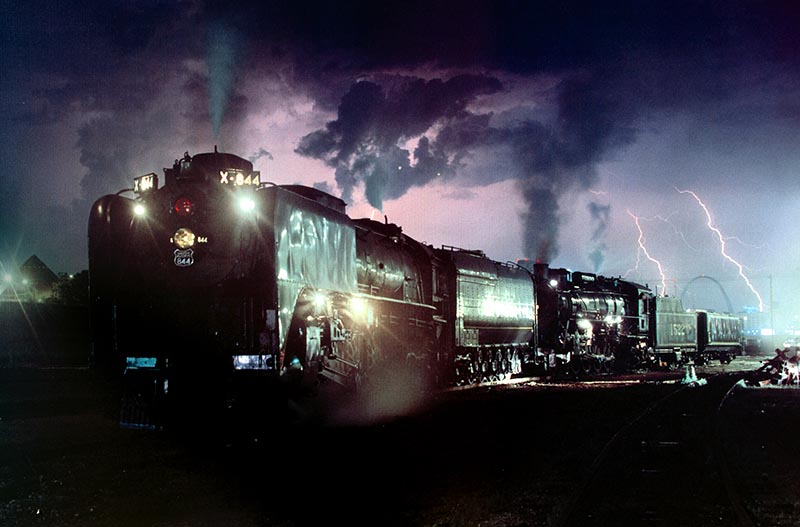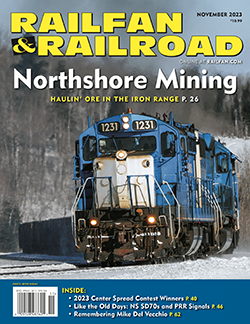 by Bruce E. Kelly/photos as noted
by Bruce E. Kelly/photos as noted
Last office on the right at the end of the hall was my humble station at Carstens Publications’ office in Newton, N.J., while I was associate editor for Railfan & Railroad from July 1988 to March 1996. It was an office I shared with Associate Editor Mike Del Vecchio, who was three years my senior and the most warm, welcoming guy that a newcomer like me could hope to team up with. During my nearly eight years living in New Jersey and working at R&R, I came to view Mike as not simply a coworker but also as a close friend.
Editor Jim Boyd hired Mike in March 1987, when R&R was only bimonthly. Strong readership and advertising revenue were about to propel R&R to full monthly publication, and having Mike on board gave Boyd the help he needed with writing some of the monthly columns, mailing photos back to contributors, and generating payments for authors and photographers. Mike came to R&R with experience in electronics sales, leadership at the Tri-State Chapter NRHS, and as a frequent contributor to Railpace and other regional publications.
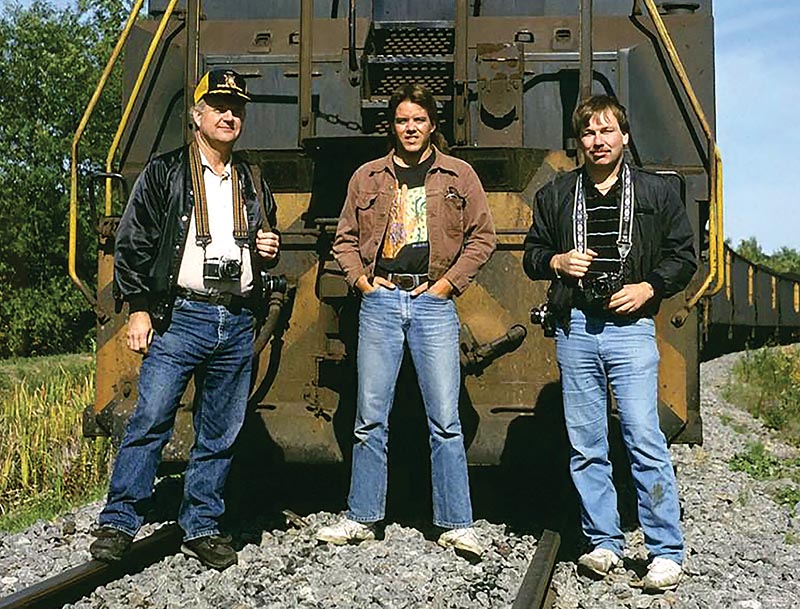
ABOVE: The Railfan & Railroad staff of 1988 poses on Lake Erie, Franklin & Clarion in western Pennsylvania. From left to right are Editor Jim Boyd and Associate Editors Bruce Kelly and Mike Del Vecchio. —Bruce E. Kelly photo
After reading my typewritten manuscript for what would become the December 1987 cover story on Burlington Northern’s Northwest Funnel, Boyd called me up and asked, “How would you like to do this for a living?” He and Del Vecchio were having a heck of a time keeping up with production of R&R after it became monthly. But hiring a third body so soon after hiring Mike was a hard sell to owner Hal Carstens. It wasn’t until July 1988 that Boyd convinced Hal to fly me to New Jersey for a trial run. After a month of writing, editing, page design, and map-making, it came time for my interview with Hal. I got the job, but not without Hal’s dire warning, “If the three of you can’t get the magazine back on schedule, you’re all fired.”
Mike’s desk was just a few feet behind mine. I could hear his every keystroke and most of his phone conversations. He and Boyd tended to come in later in the morning or even after lunch, then work their phones and computers into the evening. I was more of an 8-to-5 guy, except during deadline week at the end of the month, when all three of us would be at the office, late into the night.
Less than a week before Mike’s passing, he and I shared a long chat about those old days. He recalled how Boyd would sometimes walk up behind him and swat him on the head with a rolled up newspaper or magazine and say “bad dog” when Mike handed in a piece of writing that was over-length or rubbed Boyd’s journalistic style the wrong way. Looking back, Mike said he had nothing but admiration for Boyd, and he was grateful — as am I — for the tricks of the writing trade that the old master passed on to both of us.
Mike kept his fingers on the pulse of tourist railroads and main line steam operations to the same degree that he did the rail industry as a whole. I remember the time he got all worked up over something new called the Power Brake Rule. The way he described it to me didn’t sound like much of a big deal. But then we published his story about it in the March 1995 issue, and it became clear that Mike was among the first to recognize that a proposed FRA overhaul of brake system regulations could have widespread and costly implications for operators of vintage rolling stock.
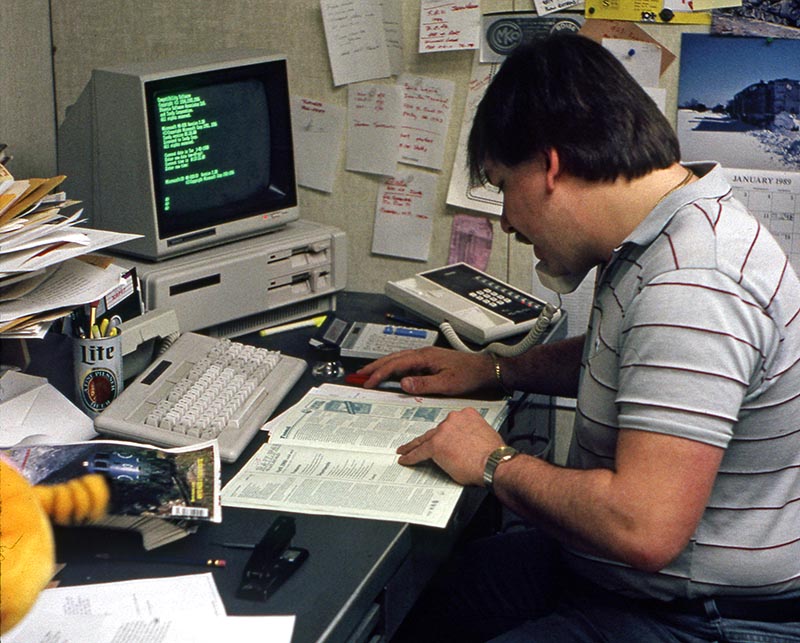
ABOVE: In February 1989, Mike is at his desk, on the phone, while flipping through a proof of the next issue of R&R about to go on press. Page layouts were done on physical art boards at the time; these simple computers were only for generating copy. Mike worked in this office at Carstens Publications in Newton, N.J., for eight years. He would spend hours on the phone each day talking to authors, photographers, and just about everyone in the rail preservation world. —Bruce E. Kelly photo
It wasn’t all work, all the time. Mike and I shared similar tastes in music, movies, and humor. He constantly offered up puns, wordplay, and distorted pronunciations, especially with railroad-related names. Among his favorites were “Horse’s Hoe Curve” (Horseshoe Curve), “Cajun Pass” (Cajon Pass), and “Needles to say,” which put a Santa Fe spin on the phrase “needless to say.”
Mike and I had many a laugh at Boyd’s expense, often stemming from the marathon road trips we took with J.B. behind the wheel. During our December 1988 trip to attend the 100-year commemoration of Canadian Pacific’s last spike being driven at Packard Brook, Maine, Boyd drove in circles for more than an hour in the middle of the night, dead set on giving us young lads the nickel tour of Northern Maine Junction. But Boyd hadn’t been there since who knows when, and finding it in the pitch black darkness of rural Maine was proving impossible for him. Mike and I just wanted to get to the motel and catch some sleep. Boyd eventually gave up his search in frustration. And for many years to come, either Mike or I would whisper “Northern Maine Junction,” whenever Boyd got lost or had a senior moment.
Some of Mike’s greatest contributions to R&R and the railfan field in general materialized during events that the magazine helped organize or sponsor. His pre-R&R electronics background and experience with slide projectors and sound systems were instrumental in pulling off the 1990s EastRAIL multimedia programs, which were inspired by the legendary Winterail shows in California. A number of NRHS conventions, tourist line photographers’ weekends, and preservation/restoration projects had Mike’s fingerprints all over them as well.
Night photography was one of Mike’s passions. Even though he was just as proficient as Boyd when it came to using flashbulbs and invested $2,000 (in 1996!) in a Lumedyne portable electronic flash system, Mike recorded some of his best nocturnal shots under ambient light. There was no finer example than the scene Mike captured during the 1990 NRHS convention in St. Louis, with UP 4-8-4 844 and Frisco 4-8-2 1522 simmering in their own steam under a stormy night sky while lightning bolts flashed above the Gateway Arch.
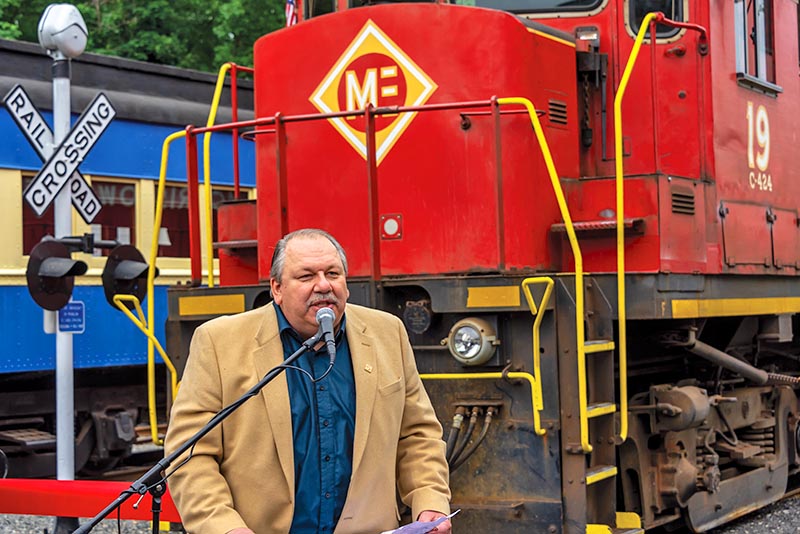
ABOVE: Mike was active in the Tri-State Railway Historical Society (which is also a chapter of the National Railway Historical Society) and served as president for many years. The organization purchased Alco C-424 19 from Morristown & Erie Railway, which was transferred to Tri-State in a ceremony on June 4, 2017. Mike was one of many speakers at Whippany, N.J., on that day. —Steve Barry photo
Boyd was tolerant of Mike and me submitting occasional photos to Railway Age because he didn’t consider the industry journal to be a direct competitor to our fan-focused magazine. I’ve been sending photos to them since the mid-1980s, and today I’m in my 11th year as a contributing editor there, working remotely from home in northern Idaho. Mike, on the other hand, took a full-time position as associate editor at Railway Age in late 1996, which resulted in his having to make a daily commute into New York City (and arriving well before lunch).
Another side gig that Mike and I capitalized on during our years at R&R was producing photography for New York, Susquehanna & Western Railway and its parent company Delaware Otsego Corp. Annual reports, calendars, and advertising for these outfits paid handsomely back in those days. Mike even went the extra mile — or should I say several thousand feet up — when he took some aerial shots for NYS&W.
After a short stay at Railway Age, Mike hired on with Morristown & Erie, eventually becoming trainmaster for the contract switching operation for the Phillips 66 refinery in Linden, N.J. The operation was taken over by short line conglomerate Watco in 2018, and it was only a few years later when Mike asked me what I knew about Great Northwest Railroad, a Watco subsidiary based in Lewiston, Idaho. He was contemplating a transfer to the Northwest to finish out his railroad career.
It’s a move I wish he could have made. I would have loved showing Mike some of the railroading in my region, the same way he so eagerly and generously shared his knowledge of Northeastern railroads with me, three long decades ago.


